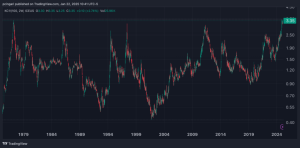
Oil prices surged on Wednesday, with West Texas Intermediate light crude rising about 4% to above $80 per barrel for the first time since mid-July 2024.
This rally comes against a backdrop of intensifying concerns over global supply disruptions and the announcement of a ceasefire in Gaza after a devastating 15-month war.
Crude prices — as tracked by the United States Oil Fund USO — haven’t seen a single-day surge of this magnitude since early October 2024.
Despite positive geopolitical developments in the Middle East with the ceasefire between Israel and Hamas, traders remain focused on tightening supply fundamentals.
According to Reuters, the ceasefire agreement, brokered by U.S., Egyptian and Qatari diplomats, outlines an Israeli military withdrawal from Gaza and a prisoner exchange.
While this marks a significant step toward de-escalation in the Middle East, oil markets seem more concerned with a series of factors that could constrain global crude flows in the near term.
The Energy Information Administration reported Wednesday a sharper-than-expected decline in U.S. crude inventories for the week ending Jan. 10, further fueling the market’s bullish sentiment.
Data showed U.S. crude oil inventories fell by 1.961 million barrels last week, exceeding market expectations of a 1.6 million-barrel draw.
This marked the eighth consecutive weekly decline, pushing U.S. crude commercial stockpiles — excluding the Strategic Petroleum Reserve — to their lowest levels since April 2022.
On Jan. 10, the Biden administration announced sweeping new sanctions targeting Russia. The measures include restrictions on two major Russian producers, Gazprom Neft and Surgutneftegaz, as well as over 160 tankers carrying oil from Russia, Iran, and Venezuela.
The sanctions also complicate ship insurance arrangements, further disrupting logistics for these nations.
The International Energy Agency, in its latest Oil Market Report released Wednesday, highlighted the potential ramifications of these sanctions, stating:
“Benchmark crude oil prices rallied in early January as U.S. sanctions on Iran and Russia intensified and freezing temperatures swept across large parts of the Northern Hemisphere.”
Speculation is mounting that the incoming U.S. administration under President-elect Donald Trump will adopt an even tougher stance on Iran, potentially exacerbating supply constraints.
“While it is too early to fully quantify the potential impact from these new measures, some operators have reportedly already started to pull back from Iranian and Russian oil,” the IEA said.
Freezing temperatures across major oil-consuming regions in the Northern Hemisphere have further tightened energy markets, boosting demand for heating fuels. This seasonal surge in consumption, combined with shrinking inventories and sanctions-related disruptions, leaves the oil market vulnerable to additional supply shocks.
“If decreases in supply from weather impacts, sanctions, or other developments become substantial, oil stocks can quickly be drawn to meet operational requirements in the near term,” the IEA stated.
Earlier this week, Goldman Sachs commodity analyst Daan Struyven warned that in a scenario of combined disruptions in Russian and Iranian oil flows, crude prices could rally up to $90 a barrel.
Read Now:
Photo: Shutterstock
Market News and Data brought to you by Benzinga APIs
© 2025 Benzinga.com. Benzinga does not provide investment advice. All rights reserved.



